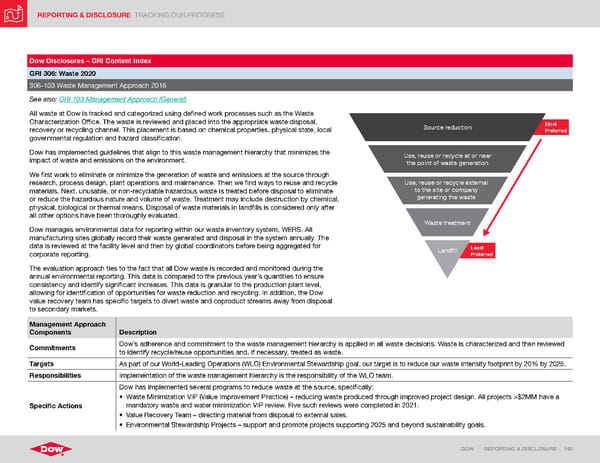REPORTING & DISCLOSURE TRACKING OUR PROGRESS DOW | REPORTING & DISCLOSURE | 145 Dow Disclosures – GRI Content Index GRI 306: Waste 2020 306-103 Waste Management Approach 2016 See also: GRI 103 Management Approach (General) All waste at Dow is tracked and categorized using defined work processes such as the Waste Characterization Office. The waste is reviewed and placed into the appropriate waste disposal, recovery or recycling channel. This placement is based on chemical properties, physical state, local governmental regulation and hazard classification. Dow has implemented guidelines that align to this waste management hierarchy that minimizes the impact of waste and emissions on the environment. We first work to eliminate or minimize the generation of waste and emissions at the source through research, process design, plant operations and maintenance. Then we find ways to reuse and recycle materials. Next, unusable, or non-recyclable hazardous waste is treated before disposal to eliminate or reduce the hazardous nature and volume of waste. Treatment may include destruction by chemical, physical, biological or thermal means. Disposal of waste materials in landfills is considered only after all other options have been thoroughly evaluated. Dow manages environmental data for reporting within our waste inventory system, WERS. All manufacturing sites globally record their waste generated and disposal in the system annually. The data is reviewed at the facility level and then by global coordinators before being aggregated for corporate reporting. The evaluation approach ties to the fact that all Dow waste is recorded and monitored during the annual environmental reporting. This data is compared to the previous year’s quantities to ensure consistency and identify significant increases. This data is granular to the production plant level, allowing for identification of opportunities for waste reduction and recycling. In addition, the Dow value recovery team has specific targets to divert waste and coproduct streams away from disposal to secondary markets. Most Preferred Least Preferred Source reduction Use, reuse or recycle at or near the point of waste generation Use, reuse or recycle external to the site or company generating the waste Wa ste treatment Landfill Management Approach Components Description Commitments Dow’s adherence and commitment to the waste management hierarchy is applied in all waste decisions. Waste is characterized and then reviewed to identify recycle/reuse opportunities and, if necessary, treated as waste. Targets As part of our World-Leading Operations (WLO) Environmental Stewardship goal, our target is to reduce our waste intensity footprint by 20% by 2025. Responsibilities Implementation of the waste management hierarchy is the responsibility of the WLO team. Specific Actions Dow has implemented several programs to reduce waste at the source, specifically: • Waste Minimization VIP (Value Improvement Practice) – reducing waste produced through improved project design. All projects >$2MM have a mandatory waste and water minimization VIP review. Five such reviews were completed in 2021. • Value Recovery Team – directing material from disposal to external sales. • Environmental Stewardship Projects – support and promote projects supporting 2025 and beyond sustainability goals.
 ESG Report | Dow Page 144 Page 146
ESG Report | Dow Page 144 Page 146